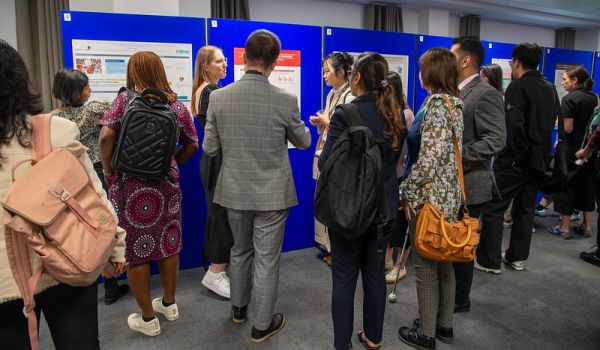Top tips for a standout conference presentation and poster
- Research and innovation

Attending and presenting at conferences is an integral part of academic life. Conferences are a fantastic way to make new connections and see old faces, keep up-to-date with the latest thinking in your field, gain feedback from your peers, raise your profile, and a chance to get out of the office/lecture hall and have a change of scenery!
Here at Leeds University Business School, we host an annual doctoral conference for our postgraduate researchers (PGRs). The conference brings together PGRs from all departments, providing a platform to present their research and make connections with other PGRs, Early Career Researchers, supervisors, and colleagues within the Business School.
Knowing how important conferences are in academia, the School’s doctoral conference is a great opportunity for our PGRs to develop further their presentation, communication, and networking skills in a supportive environment. The conference also provides our PGRs with an opportunity to gain constructive feedback on their research and to learn from peers they would perhaps not otherwise engage with.
To make sure our PGRs can get the most out of the conference, we also offer training sessions in advance. These include sessions on how to present and get your ideas across in a clear and engaging manner, and how to create an easy-to-read and compelling poster.
Here, members of our Graduate School and Faculty team, who have previously led these sessions, share their top tips.
How to present with confidence
Jon Baker, Business Support Assistant (PGR-related)
-
Practise your presentation as if you’re giving the presentation, including standing how you will be on the day. Preparing physically will help you feel more comfortable when you do it.
-
Breathing exercises will help calm nerves and anxiety. Breathe in through your nose for a count of three, hold for three, then out of your mouth for three. Repeat as many times as you need.
-
Don’t be frightened of making mistakes and don’t apologise. Everyone who has presented has made mistakes. Take a moment to collect yourself and carry on.
-
Keep hydrated. Make sure you have drunk water at least 30 to 60 minutes before your presentation as it takes time for your body to absorb water. Bear in mind your toilet breaks though!
-
Practise how to answer questions you don’t know the answer to. Having some stock answers will make you feel better prepared, e.g. “That’s a great question, I don’t have the full details, but I can get back to you if you’d like.”
-
Don’t be distracted by your audience - they could be looking at their phone to look something up related to your presentation; they may look bored but are interested. You have no idea what people are doing or thinking.
-
Remember to enjoy yourself. Presenting is an opportunity to showcase and celebrate yourself and the hard work you have done to get to this point.
How to create a poster
Jennifer Rodley, PGR Support Officer
Posters are a great way to share your research and start conversations with colleagues who are interested in your topic. Academic posters will generally vary according to the area and type of research but some general tips include:
-
Be an attention grabber! Poster sessions are generally during conference breaks, so your poster is competing with tea, biscuits, and networking. Make it stand out so that people want to come closer to read more.
-
Your poster must be clear from three metres away and text must be readable from one metre away.
-
A poster is a conversation starter, so you don’t need to include lots of detailed information. Don't put too much text on your poster so that it looks like an essay on a wall.
-
Decide what your poster-viewers must know, what would be good for them to know, and what would be nice for them to know - then prioritise these things in that order.
-
Know your audience and tailor your poster to them (e.g. are they academics knowledgeable in your research field or a more general audience from different areas of research?).
-
Use eye-catching images or diagrams instead of text where you can. Remember to check that any images have enough pixels when blown up to the size of your poster so that they don’t look blurry.
-
Consider text and background colours to help your text or images stand out.
-
Make sure you check and follow the conference poster requirements regarding size and orientation as well as submission deadlines. Some conferences may not accept posters that do not follow published guidelines.
-
Submit your poster as a PDF unless asked otherwise – if you need to print your own poster for a conference you can do this at the University Print and Copy Bureau on campus.
-
If you’ve never done a poster before, you can find a guide on how to create a poster in PowerPoint in Minerva under the Graduate School Organisation.
The full programme, as well as information about presentation and poster sessions, is available on the conference webpage.
We look forward to seeing our PGRs at the Doctoral Research Conference on 6 June 2025 and hearing all about their innovative research!
Contact us
If you would like to get in touch regarding any of these blog entries, please contact:research.lubs@leeds.ac.uk
Click here to view our privacy statement. You can repost this blog article, following the terms listed under the Creative Commons Attribution-NonCommercial-NoDerivatives 4.0 International licence.
The views expressed in this article are those of the author and may not reflect the views of Leeds University Business School or the University of Leeds.

